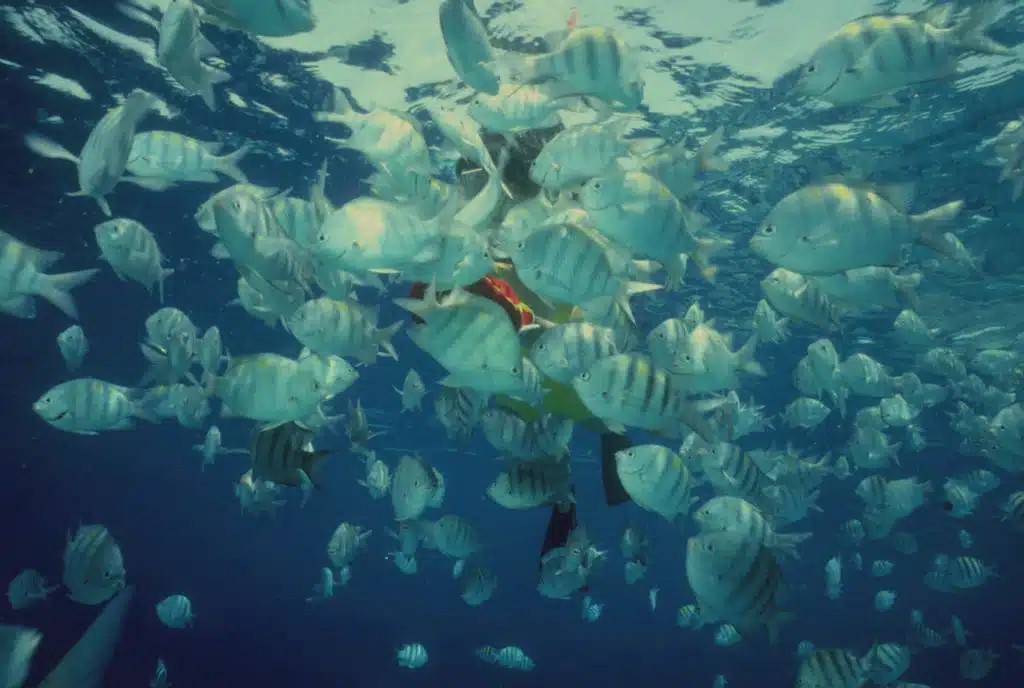Smoke from fires raging through tropical forests near coastal reefs can cause an algal bloom capable of killing virtually all coral and fish for hundreds of kilometres, according to new research by Australian National University scientists.
This discovery explains the mysterious death of nearly all coral and fish in a 400 kilometre stretch of the Mentawai Islands reef, southwest of Sumatra in Indonesia, in 1997.
In a paper published in the latest issue of Science, a team of ANU researchers reveal that nutrients in smoke from the 1997 Indonesian wildfires produced a large algae bloom, known as a red tide, that suffocated the reef ecosystem – over a distance equivalent to around a quarter of Australia’s Great Barrier Reef.
By examining the skeletal growth and geochemistry of Porites corals, researchers led by Ms Nerilie Abram, were able to track the environmental factors which led to the red tide. In examining fossilised corals, they found the red tide had been the worst in 7000 years.
“This was an extreme event and almost six years on, the reefs still haven’t recovered,” says Nerilie. “We fear that future fires could further damage the reefs before they can recover.”
The researchers found that thick smoke from the 1997 Sumatra fires released almost 11,000 tonnes of iron into the atmosphere. The iron acted as a fertiliser, increasing water nutrient levels and providing the extraordinary conditions which led to the red tide algal bloom. The bloom led to reef death by asphyxiation.
Cores from rare corals that survived the 1997 red tide showed a clear hiatus in growth at the time of the fires.
“When fires burn they release nutrients and this study has shown that these nutrients can create serious problems for coral reefs.”
“Indonesia’s reefs are the most diverse in the world and are an important source of new corals that help to rejuvenate Australia’s coral reefs. They are estimated to generate approximately US$4 billion a year in tourism, fishing and employment for Indonesia.”
“Unfortunately they are also among the most threatened reefs in the world and conservation projects are of high-priority.”
“It is expected that this new threat to coral reefs and other coastal ecosystems will increase in the future as global warming and forest clearing lead to more wildfires.”
Nerilie is presenting her research to the public for the first time thanks to Fresh Science, a national program to bring public attention to the remarkable unsung achievements of young Australian scientists. Nerilie will be speaking to the public and school students about her work on Tuesday 19 and Wednesday 20 August at the Melbourne Museum.
PhD student (final year) Research School of Earth Sciences,
Fire: the new threat to coral reefs
Coral reef death during the 1997 Indian Ocean Dipole linked to Indonesian wildfires
Fires represent a new and unexpected threat to coral reefs. It has been found that the nutrients released by wildfires can produce large algae blooms in the ocean that suffocate fish and coral. Global warming has seen a recent increase in wildfires and this trend is expected to continue, raising the future risk to coral reefs.
Project description
Coral reefs, the so-called “rainforests of the sea”, are being threatened by fire. That is the finding of scientists working at the Australian National University.
Over recent years, global warming has combined with forest clearing to produce some of the worst wildfires in history. In 1997 the wildfires in Indonesia burnt out of control for over five months, blanketing southeast Asia and northern Australia in thick smoke and leading to major environmental and health problems.
Now, new research from the ANU’s Research School of Earth Sciences has found a link between wildfires and reef death in Indonesia. “When fires burn they release nutrients and this study has shown that these nutrients can create serious problems for coral reefs”, says Nerilie Abram, the leader of this research.
Indonesia’s reefs are the most diverse in the world and are an important source of new corals that help to rejuvenate Australia’s coral reefs. They are estimated to generate around US$4 billion a year in tourism, fishing and employment for Indonesia. Unfortunately they are also among the most threatened reefs in the world and conservation projects are of high-priority.
Ms Abram has been studying a reef in western Indonesia where nearly all of the coral and fish mysteriously died in 1997. Reef death extended over 400km, equivalent to around ¼ the length of Australia’s Great Barrier Reef. Now it has been shown that nutrients in smoke from the 1997 fires produced a large algae bloom, known as a red tide, that suffocated the reef ecosystem.
Using fossil corals this research has also shown that over the last 7000 years the reefs had not previously experienced a red tide like 1997. “This was an extreme event and five-and-a-half years on the reefs still haven’t recovered”, says Ms Abram. It i
The incidence and extent of wildfires is predicted to increase with future global warming. Understanding this new link between forest wildfires and coral reef death will be important in efforts to preserve these environments for future generations.
Personal details
Qualifications: The Australian National University, BSc Advanced (Hons); The University of Sydney, 2000, First class honours and university medal





 Fresh Science is on hold for 2022. We will be back in 2023.
Fresh Science is on hold for 2022. We will be back in 2023.